Abstract
Given the widespread use of commercial probiotics in aquaculture, it is important to evaluate the quality and environmental effects of these additives. Here, the effects of a Bacillus probiotic compound, BG4, on Penaeus vannamei survival rate, water quality factors, and microbial communities were assessed. An analysis of the BG4 powder confirmed the content of probiotic bacteria: 50.2% Bacillus licheniformis, 48.4% Bacillus subtilis, and 1.4% Bacillus amyloliquefaciens, consistent with the information on the product packaging. The effective bacterial quantity (1.1 × 109 CFU/g) was higher than that indicated on the product label (2 × 108 CFU/g). BG4 was added to a sterilized aquaculture water system, according to the indicated bacterial quantity; after 7 days, the maximum ammonia nitrogen, phosphate, and chemical oxygen demand degradation rates were 36.3%, 28.9%, and 15.2%, respectively. In the shrimp culture experiment, the survival rate of P. vannamei and water quality did not differ significantly between the BG4 and control groups. The bacterial quantity and high-throughput sequencing results indicated that Bacillus content in BG4 group decreased continuously from 3.5 × 104 CFU/mL to 6.9 × 102 CFU/mL. To ensure the desired effect of probiotics in commercial aquaculture applications, additional quality evaluations and scientific assessments are needed.
Keywords:
commercial Bacillus probiotic; composition analysis; water quality factors; microbial community Key Contribution:
1. The Bacillus probiotic, BG4, had a certain degradation effect on water quality factors in the sterilized aquaculture water system. 2. BG4 did not significantly influence water quality and the survival rate of Penaeus vannamei in 7 days in the shrimp culture system.
1. Introduction
Probiotics have been widely used in aquaculture to enhance the water quality of the aquaculture ponds [1]. Among them, Bacillus probiotics are most commonly used [2], with the goal of improving water quality [3], inhibiting harmful bacteria and algal blooms [4,5], and promoting the growth of fish and other farmed species [6]. Since the 1990s, commercial probiotics have been used in aquaculture in China. After 30 years of development, commercial Bacillus probiotics have been extensively applied in the production of the main aquaculture species, especially Pacific white shrimp, Penaeus vannamei [7], which is the most economically important crustacean species in global seafood aquaculture [8].
Bacillus is a Gram-positive, spore-producing, bacterium with a high level of stress tolerance [2]. Bacteria of this genus secrete extracellular enzymes that degrade organic matter, ammonia nitrogen (NH4+−N), and nitrite nitrogen (NO2−−N) [9]. Liang et al. [10] evaluated the pollutant degradation effect of Bacillus licheniformis BSK-4 in a system of cultured Ctenopharyngodon idellus. The authors reported that BSK-4 significantly degraded total nitrogen and NO2−−N, with maximum degradation rates of 35.95% and 96.70%, respectively. Lalloo et al. [11] showed that under the synergistic effect of Bacillus subtilis B001, Bacillus cereus B002, and B. licheniformis B003, the levels of NH4+−N and NO2−−N in the water of aquaculture carp were significantly reduced, with degradation rates of 74% and 77%, respectively. Kewcharoen et al. [12] added B. subtilis AQAHBS001 to the feed of P. vannamei and found that its growth was significantly improved. Li et al. [13] demonstrated that the combination of Bacillus giant AO and B. subtilis BS significantly reduced the level of NH4+−N and NO2−−N in the aquaculture water of crucian carp, increased the microbial diversity in aquaculture water, and reduced the abundance of pathogenic bacterial genera. During production, commercially circulated Bacillus products prepared from Bacillus bacterial fluid undergo multiple processes, such as industrialized fermentation, product circulation, and storage [14]. Thus, the application effect of inoculant products and the characteristics of the pure bacterial strains may vary [15]. Li and Boyd [16] studied the degradation effects of 12 types of bacterial agents on total ammonia nitrogen and NO2−−N in an environmentally controlled aquarium and found no obvious degradation effect.
Researchers have focused on the isolation and screening of high-efficiency Bacillus strains and their effects [17]; the composition of commercial Bacillus products and their effect on water microbial communities and water quality are not well understood [18,19]. However, in order to standardize the management of fishery probiotics, scientific evaluation of the effect of current probiotics (such as commercial Bacillus probiotics) is necessary and would aid in the development of evidence-based proposals for sustainable development of the industry.
The commercial probiotic Bacillus compound, BG4, a common aquatic probiotic product in Chinese fisheries, was selected as the research object. We analyzed the quantity and composition of Bacillus in BG4 and the effect of BG4, in water sourced from an aquaculture pond and then sterilized, on the P. vannamei survival rate and microbial community structure. The results contribute to a more comprehensive evaluation of the quality of commercial Bacillus products in aquaculture and the standardized management of probiotics applied in aquaculture, with the goal of promoting sustainable development of fishery microbial resources.
2. Materials and Methods
2.1. Experimental Material
The commercial compound Bacillus probiotic BG4 was collected from a aquafarm in Guangdong province of China, which was a common aquatic probiotic product.
2.2. Bacterial Composition Analysis of BG4
2.2.1. Activation of BG4
According to the method of activation of BG4 indicated on the product label, 2.5 g of BG4 and 1.5 g of brown sugar were added to an Erlenmeyer flask containing 500 mL of sterile water and placed in a shaker for 12 h at a culture temperature of 30 °C and a rotation speed of 180 rpm. Three parallel samples were prepared.
2.2.2. Bacterial Composition Analysis of BG4
BG4 (25 g) was added to 225 mL of 0.85% sterilized normal saline and homogenized to make a suspension. Subsequently, 0.85% sterilized normal saline was used for gradient dilution, and three appropriate dilutions (−5, −6, and −7 gradients) were chosen. The bacterial suspension was heated in a water bath at 80 °C ± 1 °C for 10 min. Thereafter, 0.1 mL of the suspension was spread on nutrient agar plates and incubated at 37 °C for 48 h [20]. After colony formation, the number of colonies was counted. The number of Bacillus species in 1 g of BG4 was counted.
2.2.3. Identification of Bacillus Species
The bacteria cultured in the nutrient agar plates were isolated and purified. And single colonies were separated and purified on the basis of the morphological characteristics of the colonies on the counting plate. Single colonies were selected, and bacterial DNA was extracted using TIANamp Bacteria DNA Kit (Tiangen Biotech, Beijing, China). The 16S rDNA fragment was amplified via PCR with the primers 8F (5′-AGAGTTTGATCCTGGCTCAG-3′) and 1492R (5′-GGTTACCTTGTTACGACTT-3′). In a 50-μL reaction system, 2 μL of template DNA was added. The reaction conditions were as follows: 95 °C for 4 min, 95 °C for 1 min, 48 °C for 1 min, and 72 °C for 2 min, 30 cycles; and 72 °C for 10 min. The amplified products were detected using 1.0% agarose gel electrophoresis and sent to Sangon Biotech (Shanghai) Co., Ltd. (Shanghai, China) for sequencing.
2.3. Analysis of the Effect of BG4 on the Quality of Sterilized Aquaculture Water
2.3.1. Preparation of Feed Solutions
A commercially available compounded feed (Yuehai Feed Group Co., Ltd., Zhanjiang, China) containing 41% crude protein, 5% crude fat, and 16% ash as the main ingredients (mass fraction) was used in this study. The feed was dried and crushed, and 100 g of the crushed feed was mixed with 1 L of purified water. The feed solution was stored at 25 °C for 24 h.
2.3.2. Preparation of Sterilized Aquaculture Water
The feed solution was mixed with aquaculture water from the intensive aquaculture pond, at a salinity of 10‰ and a volume ratio of 1:100. The initial water quality concentrations were adjusted using sodium nitrite and ammonium chloride. After the adjustment, the initial chemical oxygen demand (COD) concentration of the aquaculture water was 10–15 mg/L, the initial concentrations of NH4+−N and NO2−−N were 1–3 mg/L, and the initial concentration of phosphate (PO43−−P) was 1–2 mg/L. These values were within the concentration range in water in typical aquaculture ponds [21]. Subsequently, the solution was aliquoted from 600 mL to 1 L Erlenmeyer flasks and sterilized at 121 °C for 20 min.
2.3.3. Treatment Groups
The BG4 and control groups were set up as three parallel replicates; in the BG4 group, BG4 was added to the sterilized aquaculture water according to the specified bacterial quantity (5 × 104 CFU/mL) in the product description. In the control group, normal saline was added to the same volume as the treatment mixture used in the BG4.
2.3.4. Water Quality Indicators
Water was sampled on experimental days 0, 3, and 7. The NH4+-N, NO2−-N, nitrate nitrogen (NO3−−N), PO43−−P, and COD concentrations were measured using indophenol blue spectrophotometry, naphthyl ethylenediamine spectrophotometry, zinc cadmium reduction method, phosphomolybdate blue spectrophotometry, and alkalic potassium permanganate according to GB17378.4−2007 [22].
2.4. Effects of BG4 on Shrimp and Aquatic Environment
The effects of the bacterial cultures contained in BG4 on P. vannamei and the aquatic environment were investigated.
2.4.1. Experimental System
Similar sized (PL10) cultured P. vannamei were selected. The shrimp were allowed to adapt to the aquaculture environment for 1 week, after which they were randomly placed in an aquarium with a size of 50 cm × 30 cm × 80 cm. Six aquariums (30 L each) were set up, and each aquarium contained 30 shrimp. After allowing the shrimp to adapt to the aquarium environment, they were fed twice a day, at 8:00 and 18:00, until most of them no longer fed. The experimental water came from an intensively farmed shrimp pond. During the experiment, the water was aerated without changing the water.
2.4.2. Experimental Design
BG4 and control groups were prepared with three parallel setups. In the BG4 group, BG4 was added to aquaculture water where P. vannamei were cultured in an amount based on the bacterial quantity indicated in the product description (5 × 104 CFU/mL). In the control group, the same volume of normal saline as BG4 was added.
2.4.3. Detection of Indicators
- Survival rate of Penaeus vannamei
The survival status of P. vannamei was observed in the aquarium on experimental days 0, 1, 3, and 7, and the number of shrimp in the aquarium was recorded. Any dead shrimp were immediately removed, using a fresh dip net each time. The survival rates were calculated.
- Water quality
On experimental days 0, 1, 3, and 7, the basic physical and chemical indicators of water quality, namely temperature, pH, and dissolved oxygen (DO), as well as the concentration of NH4+−N, NO2−−N, NO3−−N, PO43−−P, and COD, were measured from the water samples from the aquariums. Concentrations were measured as previously described.
- Bacterial quantity and microbial community structure
From the water samples collected on days 0, 1, 3, and 7, appropriate dilutions of the bacterial solutions were aspirated using sterile pipettes. The number of bacteria in the water sample was counted with a hemocytometer. Heterotrophic bacteria were quantified using the agar plate counting method and counted after 48 h of culture at a constant temperature of 30 °C.
Water samples (100 mL) from the BG4 and control groups were filtered through a 0.22 μm filter membrane (Millipore, Boston, USA). Total bacterial DNA was extracted from water samples using a microbial DNA extraction kit (Omega, Norcross, USA). The primers 515F (5′-GTGCCAGCMGCCGCGGTAA-3) and 907R (5ʹ-CCGTCAATTCMTTT RAGTTT-3ʹ) were used to amplify the 16S V4-V5 variable region, and an amplified library was constructed. The composition of the microbial community in the water of each experimental group was analyzed by comparing it with that in the SILVA database.
2.5. Statistical Analysis
The degradation rate (R) of each water quality indicator was calculated as follows:
All data are presented as the mean ± standard deviation. Significant differences in the data of each group were compared through one-way ANOVA after LSD test using SPSS software (version 20.0); the significance level was set at p < 0.05.
3. Results
3.1. Analysis of Bacterial Species Composition of BG4
The BG4 product was found to contain more than 2 × 108 CFU/g Bacillus, which is the main ingredient marked on its label. The effective bacterial quantity of BG4 obtained by spread plate method was 1.1 × 109 CFU/g. The single colonies were separated and purified on the basis of the morphological characteristics of the colonies on the counting plate. The single colonies were identified individually using 16S rDNA. The results showed that the probiotic BG4 product was composed of 50.2% B. licheniformis, 48.4% B. subtilis, and 1.4% B. amyloliquefaciens (Table 1), which was consistent with the main Bacillus components indicated on the product packaging. The bacterial count was higher than the count that was indicated on the product packaging (2 × 108 CFU/g).

Table 1.
Bacterial species composition of commercial Bacillus probiotic BG4.
3.2. Effect of BG4 on the Quality of Sterilized Aquaculture Water
The COD in the BG4 group on day 7 was 15.2%, decreasing from 15.44 to 13.09 mg/L (p < 0.05, Figure 1A). The NO2−−N concentration decreased from 1.12 to 0.72 mg/L, and the degradation rate on day 7 was 36.3% (p < 0.05, Figure 1B). The NO3−−N degradation rate was 17.4% compared with that of the control group on day 7 (Figure 1D). The PO43−−P concentration decreased from 1.51 mg/L to 1.09 and 1.17 mg/L on days 3 and 7, respectively, with a degradation rate of 28.9% and 22.5%, respectively (p < 0.05, Figure 1E). The quantity of bacteria in the BG4 group increased from 2 × 104 CFU/mL on day 0 to 1 × 108 CFU/mL on days 3 and 7 (Figure 1F).
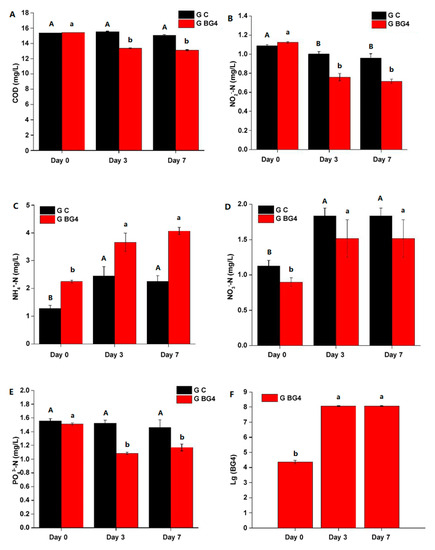
Figure 1.
Effect of commercial Bacillus probiotic BG4 on the water quality indicators of sterilized aquaculture water and variation in bacterial quantity. (A) Chemical oxygen demand (COD), (B) NO2−−N, (C) NH4+−N, (D) NO3−−N, (E) PO43−−P, and (F) Bacterial quantity. Different uppercase letters indicate significant differences in data at different time points between control groups (p < 0.05), and different lowercase letters indicate significant differences in data at different time points between BG4 groups (p < 0.05).
3.3. Effects of BG4 on Aquaculture Organisms and Aquatic Environment
3.3.1. Survival rate of Penaeus vannamei
The survival rates of P. vannamei was greater than 94% in both the BG4 and control groups; there was no significant difference between BG4 treatment and control on days 0, 1, 3, and 7 (p > 0.05; Figure 2A).
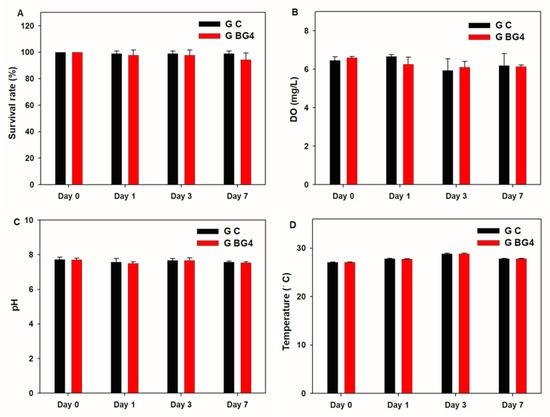
Figure 2.
Survival rate of Penaeus vannamei (A), dissolved oxygen (B), pH (C), and temperature (D) of aquaculture water in the BG4 and control groups.
3.3.2. Effects of BG4 on Aquatic Environment
- Basic indicators
The DO, pH, and temperature of the culture water in the control and BG4 groups were within the optimal ranges for P. vannamei and did not differ significantly (p > 0.05). The concentration of DO in the control and BG4 groups was 5.94–6.66 mg/L and 6.10–6.59 mg/L, respectively (Figure 2B). The pH in the control and BG4 groups was 7.57–7.73 and 7.50–6.59, respectively (Figure 2C). The temperature range of the two groups was 27.03–28.83 °C (Figure 2D).
- Water quality
The concentrations of N and P forms in the water of both BG4 and control groups showed an upward trend, which could be attributed to the addition of feed over the course of the 7 days. During the experiment, the NH4+−N (Figure 3A), NO2−−N (Figure 3B), NO3−−N (Figure 3C), PO43−−P (Figure 3D), and COD (Figure 3E) concentrations did not significantly differ between the two groups (p > 0.05).
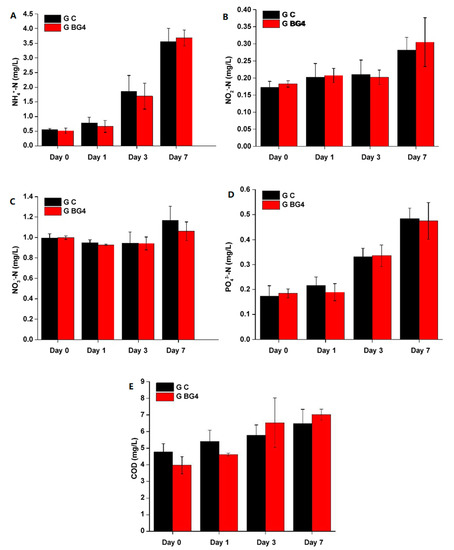
Figure 3.
Effect of commercial Bacillus probiotic BG4 on the water quality indicators in the shrimp culture water. (A) NH4+−N, (B) NO2−−N, (C) NO3−−N, (D) PO43−−P, and (E) COD.
3.4. Effects of BG4 on the Number of Bacteria and Community Structure in the Shrimp Culture Water
3.4.1. Changes in the Total Number of Bacteria in the Shrimp Culture Water
Throughout the experiment, the total number of bacteria in the water remained stable at 3 × 106–4 × 106 cells/mL, and no significant differences were found between the groups (p > 0.05; Figure 4). The application of the inoculant product in accordance with its recommended amount only slightly affected the total number of bacteria in the water.
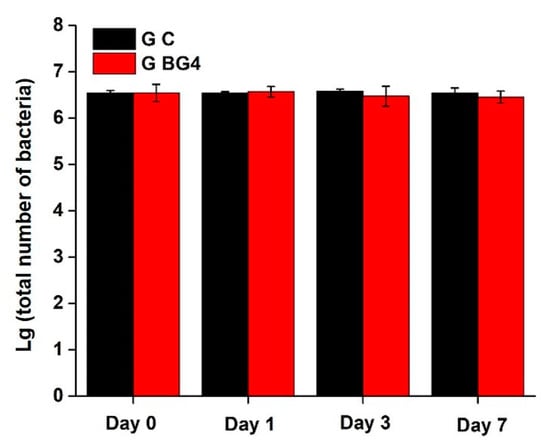
Figure 4.
Variation in bacterial quantity of shrimp culture water of the BG4 and control groups.
3.4.2. Changes in Bacterial Community Structure in the Shrimp Culture Water
Changes in the composition of the bacterial communities in the BG4 and control groups during the experiment were analyzed using high-throughput sequencing. At the beginning of the experiment, the dominant bacteria in the two groups were members of the phyla Proteobacteria, Bacteroidetes, and Firmicutes, which, in the control group, represented 50.48%, 21.98%, and 17.44%, respectively, of the bacteria. In the BG4 group, the relative abundance of these phyla were 44.46%, 18.19%, and 26.60%, respectively (Figure 5). On experimental day 1, the proportion of bacteria in Proteobacteria, Bacteroides, and Firmicutes was 30.11%, 40.41%, and 20.36% in the control group and 49.02%, 26.62%, and 15.45% in the BG4 group, respectively. On day 3, the corresponding proportions were 51.50%, 38.59%, and 5.25% in the control group and 64.58%, 24.83%, and 0.47% in the BG4 group. In the BG4 group, the relative abundance of Firmicutes was lower than that in the control group (p < 0.05). On day 7, Proteobacteria, Bacteroides, and Firmicutes represented 55.88%, 27.68%, and 6.40% of all bacteria in the control group and 54.75%, 31.76%, and 0.65% in the BG4 group. The percentage of bacteria in the BG4 group that were members of phylum Firmicutes was less than the corresponding portion in the control group (p < 0.05).
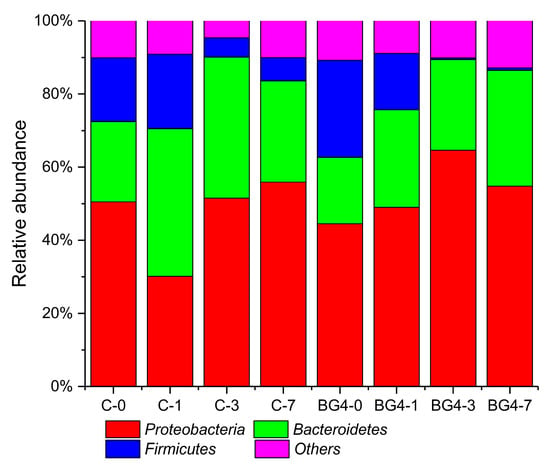
Figure 5.
Relative abundance of bacterial communities in the shrimp culture water of the BG4 and control groups at the phylum level.
Twelve dominant bacterial genera were detected: Bacillus, Bergeyella, Neisseria, Acidovorax, Bacteroides, Acinetobacter, Moraxella, Flavobacterium, Erythrobacter, Gemmobacter, Lactobacillus, and Rhodopseudomonas. On day 0, the average proportion of Bacillus was 1.01% in the BG4 group (Figure 6), which was significantly higher than that in the control group (p < 0.05). The average proportion of Bergeyella was significantly higher in the BG4 group than in the control group (p < 0.05), and the average proportions of Moraxella and Flavobacterium in the BG4 group were significantly lower than those in the control group (p < 0.05). On day 1, the average proportion of Bacillus was 0.21% in the BG4 group (Figure 6), which was not significantly different from that in the control group (p < 0.05). In the BG4 group, the relative abundance of Acidovorax, Erythrobacter, Flavobacterium, and Gemmobacter was significantly higher than the corresponding values in the control group (p < 0.05). On day 3, the average proportion of Bacillus was 0.07% in the BG4 group (Figure 6), which was significantly lower than that in the control group (p < 0.05). The relative abundance of both Flavobacterium and Gemmobacter in the BG4 group was significantly higher than that in the control group (p < 0.05), and the average proportion of Bergeyella was significantly lower in the BG4 group than in the control group (p < 0.05). On day 7, the average proportion of Bacillus was 0.02% in the BG4 group (Figure 6), which was significantly lower than that in the control group (p < 0.05). Similarly, the relative abundance of Acinetobacter was significantly lower in the BG4 group than in the control group (p < 0.05); however, the average proportion of Flavobacterium was significantly higher in the BG4 group than in the control group (p < 0.05).
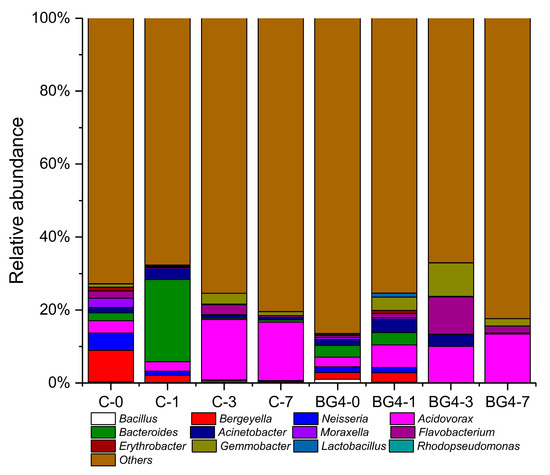
Figure 6.
Relative abundance (genus level) of bacterial communities in the shrimp culture water of the BG4 and control groups.
Based on the number of bacteria in the shrimp culture water and the high-throughput sequencing results on experimental days 0, 1, 3, and 7, the relative abundance of Bacillus at the genus level was 1.01%, 0.21%, 0.07%, and 0.02%, respectively; and the corresponding counts were 3.5 × 104, 7.3 × 103, 2.4 × 103, and 6.9 × 102 CFU/mL. The initial quantity of Bacillus added in the BG4 group was 3.5 × 104 CFU/mL, which was the same as that in the product description (Figure 7).
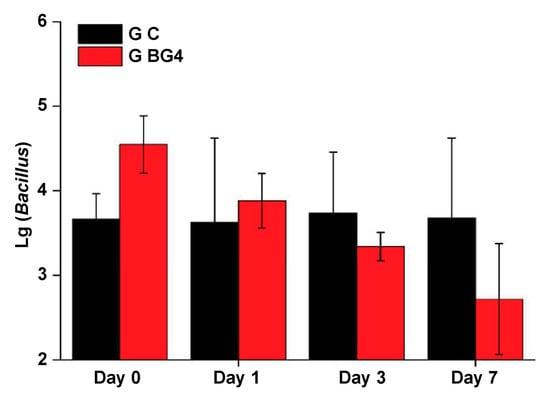
Figure 7.
Changes in the bacterial count of Bacillus in the control and BG4 groups of shrimp culture water over 7 days.
4. Discussion
Since the 1990s, commercial probiotics have been used in aquaculture in China. Species of Bacillus produce a large number of highly active proteases, lipases, amylases, and other enzymes, which rapidly degrade macromolecular organic compounds, such as proteins, fats, and starch, present in aquaculture water [19,23]. Commercial Bacillus probiotics have been extensively applied in the culture of several aquaculture species, especially shrimp [24,25,26]. According to the Catalog of Feed Additives of the Ministry of Agriculture of China 2013, Announcement No. 2045, Bacillus species that can be used as additives in aquaculture include B. licheniformis, B. subtilis, B. pumilus, B. coagulans, and B. lentus. In this study, the main components of BG4 were B. licheniformis and B. subtilis, which meet the requirements of the Catalog of Feed Additives. In addition, B. licheniformis and B. subtilis are the most studied species of Bacillus with respect to purification function [27,28]. The quantity of Bacillus in the product used in the present study exceeded the quantity marked on the product package, meeting the requirements of product quality.
In studies of the aquaculture effects of Bacillus, the results show that Bacillus species promote effective aquaculture by improving and regulating water quality, microalgae communities [14], and microbial communities [5]. Among them, B. licheniformis and B. subtilis are often considered to have good water purification function. Cao et al. [27] studied the application effect of B. licheniformis in the culture of Ctenopharyngodon idellus and found that the concentration of NH3−N and NO2−−N in the Bacillus group decreased by 74.6% and 69.3%, respectively. Liu et al. [28] found that B. subtilis WH1 significantly reduced NO2−−N, NH3−N, and COD concentrations in water (p < 0.05). The addition of B. subtilis (108 CFU/mL) directly to the rearing water maintained the concentrations of NH4+−N, NO2−−N, and NO3−−N within the tolerable ranges for shrimp culture [29]. Bacillus bacteria decompose organic matter in water, reducing COD in water and converting organic matter into inorganic nutrients such as NH4+−N [30]. These results indicate that the Bacillus probiotics of BG4 has a certain effect on water purification.
The goal of the present study in a sterilization system was to evaluate the effect of probiotics on water quality without the interference of other factors. The results of the present study are consistent with previous reports, to a certain extent. In the sterilized aquaculture water system, the maximum NO2−−N, PO43−−P, and COD degradation rates in the BG4 group were 36.3%, 28.9%, and 15.2%, respectively, and their concentrations decreased from 1.12, 1.51, and 15.44 mg/L to 0.72, 1.09, and 13.09 mg/L, respectively. However, the water quality did not significantly differ between the BG4 and control groups over 7 days. This was consistent with the research of Li and Boyd [16]. The authors found that, in an environmentally controlled aquarium, 12 bacterial agents showed no obvious effect on water quality. Likewise, Zheng et al. [15] studied the effect of a Bacillus preparation on the mixed culture water of mussels and fish and found that the probiotic had no significant effect on the level of nitrogen and phosphorus in the water. It is worth noting that in an environmentally controlled aquarium, the quantity of microalgae is very small; therefore, the normal synergistic effect of bacteria and microalgae in aquatic environments cannot be realized in the sterilized water system.
As the experiment progressed, the bacterial community structure of the control and BG4 groups changed significantly, possibly because regular addition of feed changed the nutritional status of the water [31]. The composition of bacterial community structure in the control and BG4 groups was different. This result was consistent with related reports, showing that commercial probiotic products can change the natural bacterial community [25]. The effect of commercial probiotic products on natural bacteria may be related to the competition between foreign and natural bacteria or the adaptation of foreign bacteria to the natural environment [32]. The number of bacteria in shrimp culture water and the high-throughput sequencing results indicated that the bacterial count of Bacillus in the BG4 group decreased continuously from 3.5 × 104 CFU/mL to 6.9 × 102 CFU/mL during the experiment. This indicated that Bacillus did not proliferate in this experimental system, and its function may be affected by the shrimp culture water environment [33]. Li et al. [34] and Cao et al. [35] studied cultured ponds of P. vannamei and the mixed ponds of shrimp–fish–crab and found that the quantity of Bacillus was between 60 and 1.7 × 103 CFU/mL. Compared with this data, it was found that the bacterial count of Bacillus decreased to the level of the common aquaculture pond after 7 days. This above research showed that the characteristics and effects of probiotic products may differ from those of pure bacterial strains.
5. Conclusions
We conclude that the Bacillus probiotic, BG4, has a certain degradation effect on water quality factors such as ammonia nitrogen, phosphate, and COD in the sterilized aquaculture water system, and their degradation rates were 36.3%, 28.9%, and 15.2%, respectively. However, the survival rate of P. vannamei and water quality did not differ significantly between the BG4 and control groups in the shrimp culture experiment. Given that the difficulties of modelling the pond conditions in laboratory conditions and the specific objectives of probiotic treatment vary, as do the ecological characteristics of the different strains, it is necessary to carry out the quality evaluation and scientific assessments of probiotics at the level of the experimental system as well as aquaculture systems.
Author Contributions
Conceptualization, Y.C.; methodology, Y.C. and K.Y.; formal analysis, X.H. and H.S.; investigation, S.Z. and C.X.; data curation, X.H. and W.X.; writing—original draft preparation, X.H.; writing—review and editing, X.H. and Y.X.; Supervision, Y.C. and G.W.; funding acquisition, X.H., Y.C. and G.W. All authors have read and agreed to the published version of the manuscript.
Funding
This research was funded by the key R&D Program of Guangdong Province (2021B0202040001); the Central Public-Interest Scientific Institution Basal Research Fund, CAFS (2020TD54); the Guangdong Provincial Special Fund For Modern Agriculture Industry Technology Innovation Teams (2022KJ149); the earmarked fund for CARS-48; and the Central Public-Interest Scientific Institution Basal Research Fund, South China Sea Fisheries Research Institute, CAFS (2021SD08).
Institutional Review Board Statement
The animal study protocol was approved by the Animal Care and Use Committee of the South China Sea Fisheries Research Institute, Chinese Academy of Fishery Sciences (SCSFRI-CAFS, No. nhdf2022-02).
Data Availability Statement
The datasets generated and analyzed during the current study are available from the corresponding author on reasonable request.
Conflicts of Interest
The authors declare no conflict of interest.
References
- Gatesoupe, F.J. The use of probiotics in aquaculture. Aquaculture 1999, 180, 147–165. [Google Scholar] [CrossRef]
- Kuebutornye, F.K.A.; Abarike, E.D.; Lu, Y.S. A review on the application of Bacillus as probiotics in aquaculture. Fish Shellfish Immunol. 2019, 87, 820–828. [Google Scholar] [CrossRef]
- Elsabagh, M.; Mohamed, R.; Moustafa, E.M.; Hamza, A.; Farrag, F.; Decamp, O.; Dawood, M.A.O.; Eltholth, M. Assessing the impact of Bacillus strains mixture probiotic on water quality, growth performance, blood profile and intestinal morphology of Nile tilapia, Oreochromis niloticus. Aquac. Nutr. 2018, 24, 1613–1622. [Google Scholar] [CrossRef]
- Kavitha, M.; Raja, M.; Perumal, P. Evaluation of probiotic potential of Bacillus spp. isolated from the digestive tract of freshwater fish Labeo calbasu (Hamilton, 1822). Aquac. Rep. 2018, 11, 59–69. [Google Scholar] [CrossRef]
- Hu, X.J.; Wen, G.L.; Xu, W.J.; Xu, Y.; Su, H.C.; Yang, K.; Xu, Y.; Li, Z.J.; Cao, Y.C. Effects of the algicidal bacterium CZBC1 on microalgal and bacterial communities in shrimp culture. Aquac. Environ. Interact. 2019, 11, 279–290. [Google Scholar] [CrossRef]
- Goda, A.M.; Omar, E.A.; Srour, T.M.; Kotiet, A.M.; El-Haroun, E.; Davies, S.J. Effect of diets supplemented with feed additives on growth, feed utilization, survival, body composition and intestinal bacterial load of early weaning European seabass, Dicentrarchus labrax post-larvae. Aquac. Int. 2018, 26, 169–183. [Google Scholar] [CrossRef]
- Hu, X.J.; Cao, Y.C.; Wen, G.L.; Zhang, X.Y.; Xu, Y.; Xu, W.J.; Xu, Y.N.; Li, Z.J. Effect of combined use of Bacillus and molasses on microbial communities in shrimp cultural enclosure systems. Aquac. Res. 2017, 48, 691–2705. [Google Scholar] [CrossRef]
- Xu, W.J.; Wen, G.L.; Su, H.C.; Xu, Y.; Hu, X.J.; Cao, Y.C. Effect of input C/N ratio on bacterial community of water biofloc and shrimp gut in a commercial zero-exchange system with intensive production of Penaeus vannamei. Microorganisms 2022, 10, 1060. [Google Scholar] [CrossRef] [PubMed]
- Cai, Y.; Yuan, W.; Wang, S.; Guo, W.; Li, A.; Wu, Y.; Chen, X.; Ren, Z.; Zhou, Y. In vitro screening of putative probiotics and their dual beneficial effects: To white shrimp (Litopenaeus vannamei) postlarvae and to the rearing water. Aquaculture 2019, 498, 61–71. [Google Scholar] [CrossRef]
- Liang, Q.; Zhang, X.; Lee, K.H.; Wang, Y.; Yu, K.; Shen, W.; Fu, L.; Shu, M.; Li, W. Nitrogen removal and water microbiota in grass carp culture following supplementation with Bacillus licheniformis BSK-4. World J. Microbiol. Biotechnol. 2015, 31, 1711–1718. [Google Scholar] [CrossRef] [PubMed]
- Lalloo, R.; Ramchuran, S.; Ramduth, D.; Görgens, J.; Gardiner, N. Isolation and selection of Bacillus spp. as potential biological agents for enhancement of water quality in culture of ornamental fish. J. Appl. Microbiol. 2007, 103, 1471–1479. [Google Scholar] [CrossRef]
- Kewcharoen, W.; Srisapoome, P. Probiotic effects of Bacillus spp. from Pacific white shrimp (Litopenaeus vannamei) on water quality and shrimp growth, immune responses, and resistance to Vibrio parahaemolyticus (AHPND strains). Fish Shellfish Immunol. 2019, 94, 175–189. [Google Scholar] [CrossRef]
- Li, X.; Liu, S.F.; Yan, Y.M.; Zhang, R.J.; Wang, T.J.; Fu, B.R. Effect of Bacillus complex on water quality and bacterial community structure of Carassius aumtus culture water. J. Ecol. Rural Environ. 2020, 36, 522–530. [Google Scholar] [CrossRef]
- Hu, X.J.; Su, H.C.; Xu, Y.; Xu, W.J.; Li, S.S.; Huang, X.S.; Cao, Y.C.; Wen, G.L. Algicidal properties of fermentation products from Bacillus cereus strain JZBC1 dissolving dominant dinoflagellate species Scrippsiella trochoidea, Prorocentrum micans, and Peridinium umbonatum. Biologia 2020, 75, 2015–2024. [Google Scholar] [CrossRef]
- Zheng, X.; Tang, J.; Ren, G.; Wang, Y. The effect of four microbial products on production performance and water quality in integrated culture of freshwater pearl mussel and fishes. Aquac. Res. 2017, 48, 4897–4909. [Google Scholar] [CrossRef]
- Li, Y.; Boyd, C.E. Laboratory tests of bacterial amendments for accelerating oxidation rates of ammonia, nitrite and organic matter in aquaculture pond water. Aquaculture 2016, 460, 45–58. [Google Scholar] [CrossRef]
- Liu, S.; Wang, X.; Lin, Z.; Cai, Y.; Wu, Y.; Liu, X.; Zou, Y.; Wang, S. Purification of aquaculture effluent by Bacillus subtilis HAINUP40. Fish Sci. 2018, 37, 159–166. [Google Scholar] [CrossRef]
- Zhen, Q.I.; Yang, J.P. Application of microbiological preparation and microalgae in aquaculture. Acta Hydrobiol. Sin. 2004, 28, 85–89. [Google Scholar] [CrossRef]
- Zhang, W.; Zhang, J.; Li, Y.; Jiang, Y.; Yao, W.; Wu, Z. Water quality control in aquaculture system by Bacillus cereus S458-1. Acta Microbiol. Sin. 2019, 59, 2182–2193. [Google Scholar] [CrossRef]
- GB/T 26428-2010; Method for Determination of Bacillus subtilis in Feeds. General Administration of Quality Supervision, Inspection and Quarantine of the People’s Republic of China, China National Standardization Administration: Beijing, China, 2011.
- Cao, Y.C.; Wen, G.L.; Li, Z.J.; Liu, X.J.; Hu, X.J.; Zhang, J.S.; He, J.G. Effects of dominant microalgae species and bacterial quantity on shrimp production in the final culture season. J. Appl. Phycol. 2014, 26, 1749–1757. [Google Scholar] [CrossRef]
- GB17378.4-2007; The Specification for Marine Monitoring-Part 4: Seawater Analysis. General Administration of Quality Supervision, Inspection and Quarantine of the People’s Republic of China, China National Standardization Administration: Beijing, China, 2008.
- Zhang, D.; Li, H.; Liu, Y.; Qiao, G.; Chi, S.; Song, J. Screening and identification of organics-degrading bacteria from the sediment of sea cucumber Apostichopus japonicus ponds. Aquac. Int. 2016, 24, 373–384. [Google Scholar] [CrossRef]
- McIntosh, D.; Samocha, T.M.; Jones, E.R.; Lawrence, A.L.; McKee, D.A.; Horowitz, S.; Horowitz, A. The effect of a commercial bacterial supplement on the high-density culturing of Litopenaeus vannamei with a low-protein diet in an outdoor tank system and no water exchange. Aquacult. Eng. 2000, 21, 215–227. [Google Scholar] [CrossRef]
- Dalmin, G.; Kathiresan, K.; Purushothaman, A. Effect of probiotics on bacterial population and health status of shrimp in culture pond ecosystem. Indian J. Exp. Biol. 2001, 39, 939–942. [Google Scholar] [CrossRef]
- Wu, D.X.; Zhao, S.M.; Peng, N.; Xu, C.P.; Wang, J.; Liang, Y.X. Effects of a probiotic (Bacillus subtilis FY99-01) on the bacterial community structure and composition of shrimp (Litopenaeus vannamei, Boone) culture water assessed by denaturing gradient gel electrophoresis and high-throughput sequencing. Aquac. Res. 2016, 47, 857–869. [Google Scholar] [CrossRef]
- Cao, Y.C.; Li, Z.J.; Lin, H.Z.; Yang, Y.Y.; Wen, G.L.; Zou, G.R. Applied research of Bacillus licheniformis De in grass carp (Ctenopharyngodon idellus) culture. South China Fish. Sci. 2008, 4, 15–19. [Google Scholar] [CrossRef]
- Liu, X.Y.; Wang, L.L.; Luan, H.N.; Zheng, W.; Hou, S.; Liu, Z.; Zhang, S. Isolation and identification of a Bacillus subtilis strain for water purification. Microbiol. China 2021, 48, 449–461. [Google Scholar] [CrossRef]
- Zokaeifar, H.; Babaei, N.; Saad, C.R.; Kamarudin, M.S.; Sijam, K.; Balcazar, J.L. Administration of Bacillus subtilis strains in the rearing water enhances the water quality, growth performance, immune response, and resistance against Vibrio harveyi infection in juvenile white shrimp, Litopenaeus vannamei. Fish Shellfish Immunol. 2014, 36, 68–74. [Google Scholar] [CrossRef] [PubMed]
- Hu, X.J.; Xu, Y.; Cao, Y.C. Full-Color Illustration of Efficient Culture and Disease Control of Litopenaeus vannamei; Chemical Industry Press: Beijing, China, 2021. [Google Scholar]
- Sutyak, K.E.; Wirawan, R.E.; Aroutcheva, A.A.; Chikindas, M.L. Isolation of the Bacillus subtilis antimicrobial peptide subtilosin from the dairy product-derived Bacillus amyloliquefaciens. J. Appl. Microbiol. 2008, 104, 1067–1074. [Google Scholar] [CrossRef]
- Tyagi, M.; da Fonseca, M.M.R.; de Carvalho, C.C. Bioaugmentation and biostimulation strategies to improve the effectiveness of bioremediation processes. Biodegradation 2011, 22, 231–241. [Google Scholar] [CrossRef] [PubMed]
- Tang, J.Y.; Dai, Y.X.; Li, Y.M.; Qin, J.G.; Wang, Y. Can application of commercial microbial products improve fish growth and water quality in freshwater polyculture? N. Am. J. Aquacult. 2016, 78, 154–160. [Google Scholar] [CrossRef]
- Li, S.H.; Li, Z.J.; Yang, Y.Y.; Cao, Y.C.; Hu, X.J.; Yang, Y.F. The dynamic study of bacteria from autumn to winter in the Litopenaeus vannamei ponds. J. Jinan Univ. 2009, 30, 343–348. [Google Scholar] [CrossRef]
- Cao, Y.C.; Li, Z.; Wen, G.L.; Li, S.H.; Hu, X.J. Dynamic variation of bacteria and the relationship with water quality in marine polyculture pond. Guangdong Agric. Sci. 2013, 5, 120–130. [Google Scholar] [CrossRef]
Disclaimer/Publisher’s Note: The statements, opinions and data contained in all publications are solely those of the individual author(s) and contributor(s) and not of MDPI and/or the editor(s). MDPI and/or the editor(s) disclaim responsibility for any injury to people or property resulting from any ideas, methods, instructions or products referred to in the content. |
© 2023 by the authors. Licensee MDPI, Basel, Switzerland. This article is an open access article distributed under the terms and conditions of the Creative Commons Attribution (CC BY) license (https://creativecommons.org/licenses/by/4.0/).